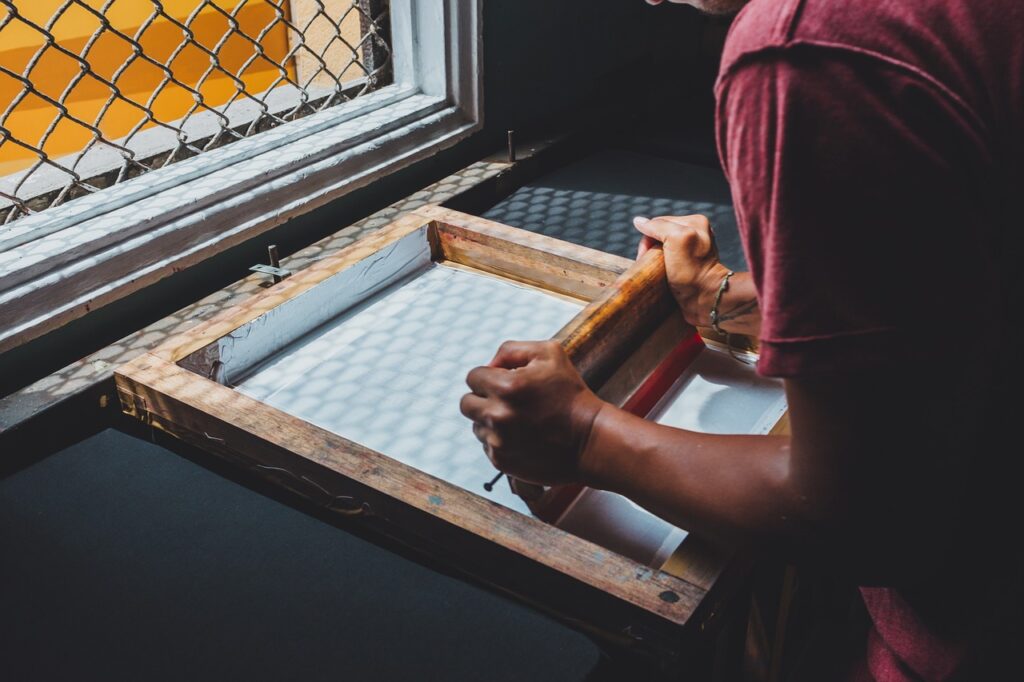What is the Difference Between Screen Printing and Digital Printing

Screen printing and digital printing are two of the most commonly employed printing methods in use today. Although they both result in an image being applied on paper or some other medium, they have a number of significant differences. Let’s take a look at the key characteristics of each as well as their benefits and drawbacks.
Differences Between Screen and Digital Printing
Screen Printing
- Mainly done by hand
- Applies ink in thick layers
- Works equally well with light and dark materials
- Produces vibrant images
- Suitable for specialty products with curved or uneven surfaces
- Not ideal for detailed work
- Usually has minimum order requirements
Digital Printing
- Mostly a computer-assisted process
- Applies ink in relatively thin layers
- Better suited for light-colored materials
- Not as vibrant as screen printing
- Not suitable for specialty products with curved and uneven surfaces
- Allows for detailed and photographic quality work
- No minimum order requirements
Primary Characteristics of Screen and Digital Printing
The ‘screen’ in screen printing refers to the stencil used to transfer ink onto the print medium. A different stencil is used for each color, and the ink is applied layer by layer until the image is printed on the material’s surface.
With digital printing, a computer image is printed directly onto the print medium. No plates or screens are used, as the ink is applied directly to the material’s surface.
Each method has its benefits and drawbacks. Some printing companies specialize only in one or the other, while some can do both depending on the project’s requirements or the client’s preferences. The printing supervisor may also recommend which method is better suited for a particular job.
Common Applications of Digital and Screen Printing
Screen printing is the better option when image vibrancy is the primary consideration. This method is often used for printing text or images on specialty items or dark fabrics.
The ink is usually applied thicker in screen printing as compared to digital printing. This makes the colors seem brighter even when the material used is extremely dark.
Screen printing is a manual process, with most of the work done by hand. Although this might seem like a disadvantage, it does allow for printing on curved and uneven surfaces. In addition, because the operator can manipulate the process as it takes place, ink can be applied more effectively to mugs, cans, bottles, and similar items.
Of course, having to control the process manually makes screen printing a more labor-intensive option. It also requires more materials than digital printing, resulting in a higher cost per print. To compensate for these factors, most companies have a minimum order requirement for screen printing.
Digital printing is the more feasible option when detailed image reproduction is essential. Because digital printers do not use screens, it is possible to produce much more detailed results than screen printing.
Digital printing is better suited for printing on light-colored material because the ink is applied relatively thinly. But, on the other hand, this allows for sharper and more detailed images.
It is also a pretty cost-effective solution for small-run print jobs. The cost per page is much lower than with screen printing, again because it doesn’t require special materials or labor-intensive processes. It is even feasible to produce only a single printed piece, which would be cost-prohibitive with screen printing.
Digital printing is more expensive at the outset due to the total outlay for the printer and the computer. The cost also increases with larger print runs. But in most cases, the investment is quickly recoupable if you mostly do small to medium runs considering the low price per page.
Should You Go For Screen Printing or Digital Printing?
When deciding between screen printing and digital printing, consider the following factors:
Color requirements. Screen printing usually produces the most vibrant colors due to the thickness of the ink applied.
Shape or surface of object. Because screen printing is a manual process, the operator can manipulate the equipment to print on curved or uneven surfaces.
Volume requirements. Digital printing is better suited for small runs due to the low cost per print. Screen printing is more expensive for smaller runs, but the price decreases with more copies printed.
Detail requirements. Digital printing is much better suited to detailed image reproduction than screen printing.
Conclusion
In general, screen printing is better suited for low detail work and large volume jobs. Digital printing, on the other hand, is the more feasible option when detailed results are desired. Making a thorough assessment of your needs will help you determine which printing method is best suited for you.
